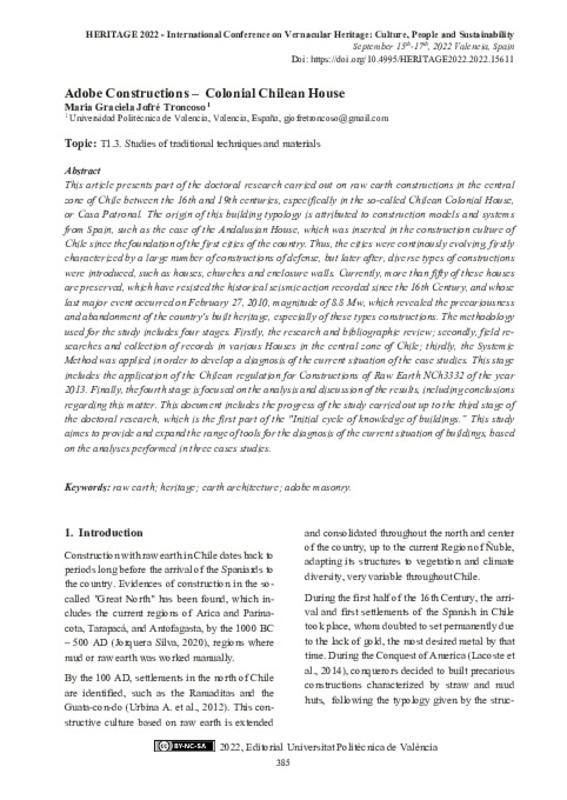JavaScript is disabled for your browser. Some features of this site may not work without it.
Buscar en RiuNet
Listar
Mi cuenta
Estadísticas
Ayuda RiuNet
Admin. UPV
Adobe Constructions – Colonial Chilean House
Mostrar el registro sencillo del ítem
Ficheros en el ítem
| dc.contributor.author | Jofré Troncoso, Maria
|
es_ES |
| dc.coverage.spatial | east=-71.542969; north=-35.675147; name=Chile | es_ES |
| dc.date.accessioned | 2022-10-27T07:26:52Z | |
| dc.date.available | 2022-10-27T07:26:52Z | |
| dc.date.issued | 2022-09-13 | |
| dc.identifier.isbn | 9788413960203 | |
| dc.identifier.uri | http://hdl.handle.net/10251/188799 | |
| dc.description.abstract | [EN] This article presents part of the doctoral research carried out on raw earth constructions in the central zone of Chile between the 16th and 19th centuries, especifically in the so-called Chilean Colonial House, or Casa Patronal. The origin of this building typology is attributed to construction models and systems from Spain, such as the case of the Andalusian House, which was inserted in the construction culture of Chile since the foundation of the first cities of the country. Thus, the cities were continously evolving, firstly characterized by a large number of constructions of defense, but later after, diverse types of constructions were introduced, such as houses, churches and enclosure walls. Currently, more than fifty of these houses are preserved, which have resisted the historical seismic action recorded since the 16th Century, and whose last major event occurred on February 27, 2010, magnitude of 8.8 Mw, which revealed the precariousness and abandonment of the country's built heritage, especially of these types constructions. The methodology used for the study includes four stages. Firstly, the research and bibliographic review; secondly, field researches and collection of records in various Houses in the central zone of Chile; thirdly, the Systemic Method was applied in order to develop a diagnosis of the current situation of the case studies. This stage includes the application of the Chilean regulation for Constructions of Raw Earth NCh3332 of the year 2013. Finally, the fourth stage is focused on the analysis and discussion of the results, including conclusions regarding this matter. This document includes the progress of the study carried out up to the third stage of the doctoral research, which is the first part of the "Initial cycle of knowledge of buildings.” This study aimes to provide and expand the range of tools for the diagnosis of the current situation of buildings, based on the analyses performed in three cases studies. | es_ES |
| dc.format.extent | 8 | es_ES |
| dc.language | Inglés | es_ES |
| dc.publisher | Editorial Universitat Politècnica de València | es_ES |
| dc.relation.ispartof | Proceedings HERITAGE 2022 - International Conference on Vernacular Heritage: Culture, People and Sustainability | |
| dc.rights | Reconocimiento - No comercial - Compartir igual (by-nc-sa) | es_ES |
| dc.subject | Raw earth | es_ES |
| dc.subject | Heritage | es_ES |
| dc.subject | Earth architecture | es_ES |
| dc.subject | Adobe masonry | es_ES |
| dc.title | Adobe Constructions – Colonial Chilean House | es_ES |
| dc.type | Capítulo de libro | es_ES |
| dc.type | Comunicación en congreso | es_ES |
| dc.identifier.doi | 10.4995/HERITAGE2022.2022.15611 | |
| dc.rights.accessRights | Abierto | es_ES |
| dc.description.bibliographicCitation | Jofré Troncoso, M. (2022). Adobe Constructions – Colonial Chilean House. En Proceedings HERITAGE 2022 - International Conference on Vernacular Heritage: Culture, People and Sustainability. Editorial Universitat Politècnica de València. 385-392. https://doi.org/10.4995/HERITAGE2022.2022.15611 | es_ES |
| dc.description.accrualMethod | OCS | es_ES |
| dc.relation.conferencename | HERITAGE2022 International Conference on Vernacular Heritage: Culture, People and Sustainability | es_ES |
| dc.relation.conferencedate | Septiembre 15-17, 2022 | es_ES |
| dc.relation.conferenceplace | Valencia, España | es_ES |
| dc.relation.publisherversion | http://ocs.editorial.upv.es/index.php/HERITAGE/HERITAGE2022/paper/view/15611 | es_ES |
| dc.description.upvformatpinicio | 385 | es_ES |
| dc.description.upvformatpfin | 392 | es_ES |
| dc.type.version | info:eu-repo/semantics/publishedVersion | es_ES |
| dc.relation.pasarela | OCS\15611 | es_ES |








